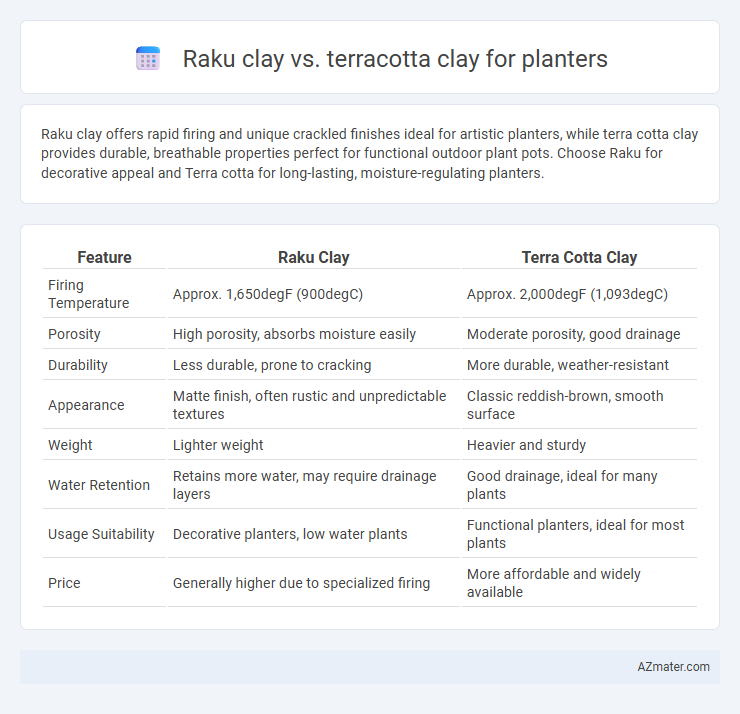Raku clay offers rapid firing and unique crackled finishes ideal for artistic planters, while terra cotta clay provides durable, breathable properties perfect for functional outdoor plant pots. Choose Raku for decorative appeal and Terra cotta for long-lasting, moisture-regulating planters.
Table of Comparison
| Feature | Raku Clay | Terra Cotta Clay |
|---|---|---|
| Firing Temperature | Approx. 1,650degF (900degC) | Approx. 2,000degF (1,093degC) |
| Porosity | High porosity, absorbs moisture easily | Moderate porosity, good drainage |
| Durability | Less durable, prone to cracking | More durable, weather-resistant |
| Appearance | Matte finish, often rustic and unpredictable textures | Classic reddish-brown, smooth surface |
| Weight | Lighter weight | Heavier and sturdy |
| Water Retention | Retains more water, may require drainage layers | Good drainage, ideal for many plants |
| Usage Suitability | Decorative planters, low water plants | Functional planters, ideal for most plants |
| Price | Generally higher due to specialized firing | More affordable and widely available |
Introduction to Raku Clay and Terra Cotta Clay
Raku clay is a specially formulated clay known for its ability to withstand rapid temperature changes during the raku firing process, making it ideal for artistic pottery with unique crackled finishes. Terra cotta clay, composed primarily of natural iron-rich clay, is widely used for traditional planters due to its porous nature, allowing excellent breathability and moisture regulation for plants. Both clays offer distinct properties: raku clay excels in decorative aesthetics with its thermal shock resistance, while terra cotta is favored for functional, breathable planters that promote healthy root systems.
Composition and Material Differences
Raku clay contains grog and organic materials that create a porous, lightweight texture ideal for artistic planters, while terra cotta clay is primarily composed of natural earthenware with high iron content, offering durability and natural reddish hues suited for functional outdoor planters. Raku's porous composition allows for faster moisture evaporation, and terra cotta's dense structure provides better water retention and frost resistance. The firing process for raku involves rapid heating and cooling, producing crackled surfaces, whereas terra cotta clay undergoes slow kiln firing at lower temperatures to achieve hardness and uniformity.
Aesthetic Qualities and Surface Texture
Raku clay offers a unique, crackled surface texture with metallic sheen and unpredictable color variations, enhancing the aesthetic appeal of planters with a rustic yet artistic finish. Terra cotta clay, known for its warm, earthy tones and porous matte surface, provides a classic and natural appearance that complements outdoor garden settings. The tactile surface of raku is often rough and irregular, while terra cotta features a smoother, more uniform texture that ages gracefully with time.
Durability and Weather Resistance
Raku clay planters exhibit higher durability due to their unique firing process, which creates a strong, crack-resistant surface ideal for outdoor exposure. Terra cotta clay planters, while aesthetically pleasing and breathable, are more porous and prone to cracking under freeze-thaw cycles or prolonged moisture exposure. For superior weather resistance, raku clay offers better longevity, especially in climates with fluctuating temperatures and humidity.
Porosity and Drainage Capabilities
Raku clay exhibits lower porosity compared to terra cotta clay, resulting in reduced water absorption and slower evaporation, which can limit drainage capabilities in planters. Terra cotta clay is highly porous, allowing superior air and water flow that enhances soil aeration and prevents waterlogging, making it ideal for plant health. The enhanced permeability of terra cotta planters supports effective drainage, which is crucial for root oxygenation and preventing root rot.
Weight and Handling for Planters
Raku clay is significantly lighter than terra cotta clay, making it easier to handle and move planters without sacrificing durability. Terra cotta clay is denser and heavier, offering stability but requiring more effort in transportation and repositioning. The lightweight nature of raku clay is ideal for large or decorative planters that need frequent relocation or indoor use.
Suitability for Plant Health
Raku clay planters offer excellent breathability and natural insulation, promoting healthy root oxygenation and moisture regulation essential for plant health. Terra cotta clay is highly porous, allowing for effective drainage and preventing root rot, making it a popular choice for a wide range of plants. Both clays support plant health effectively, but terra cotta's superior moisture evaporation is especially beneficial for drought-tolerant species.
Cost Comparison and Availability
Raku clay typically costs more than terra cotta clay due to its unique firing process and artistic appeal, often priced between $20-$30 per pound compared to terra cotta's $5-$10 per pound. Terra cotta clay is widely available at most craft stores and garden centers, making it a budget-friendly and accessible option for planters. Raku clay, while less common, can be found through specialty ceramic suppliers or online retailers, often requiring advance purchase due to limited stock.
Creative Design Possibilities
Raku clay offers unique creative design possibilities for planters due to its ability to undergo rapid cooling in the raku firing process, resulting in distinctive crackled textures and vibrant metallic glazes that cannot be replicated with terra cotta. Terra cotta clay provides a more traditional, porous surface ideal for natural, earthy aesthetics and easy customization through carving or painting but lacks the dramatic finish variety of raku. Artists seeking bold, experimental finishes favor raku clay, while those prioritizing classic, breathable planters tend to select terra cotta.
Choosing the Best Clay for Your Planter Needs
Raku clay offers a unique, crackled finish with excellent thermal shock resistance, making it ideal for decorative planters exposed to temperature fluctuations. Terra cotta clay provides natural porosity and breathability, enhancing root aeration and moisture regulation for healthy plant growth. Selecting the best clay depends on whether aesthetic appeal or functional benefits like moisture control are your primary planter needs.

Infographic: Raku clay vs Terra cotta clay for Planter
 azmater.com
azmater.com